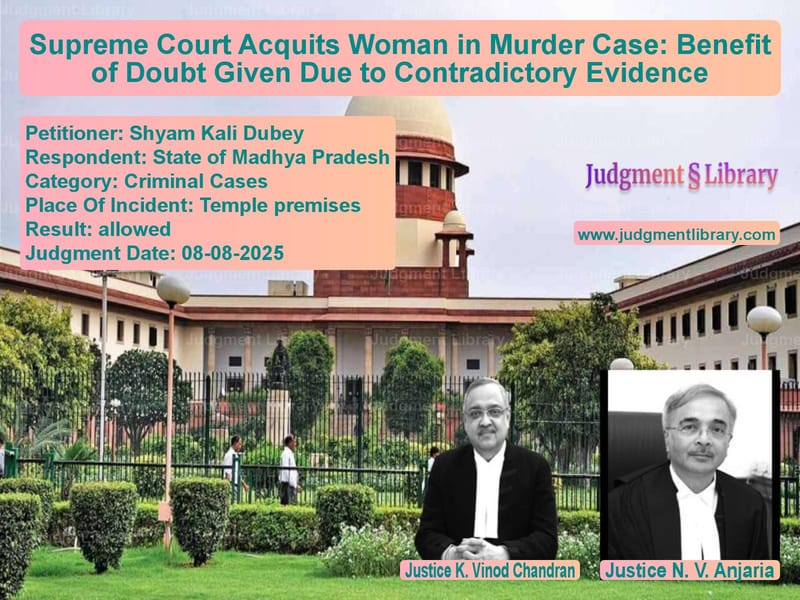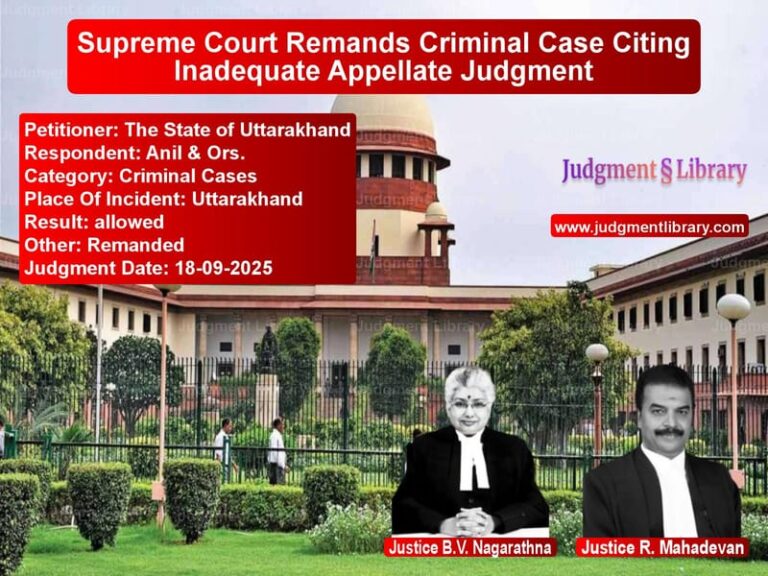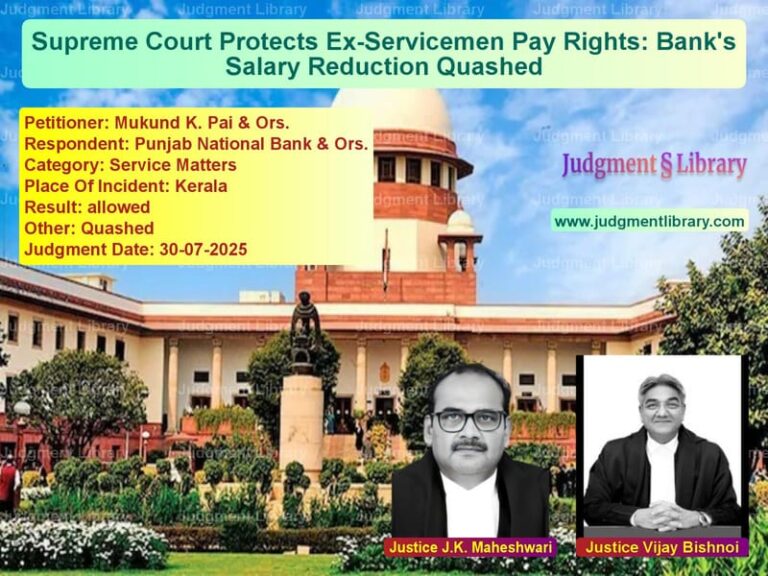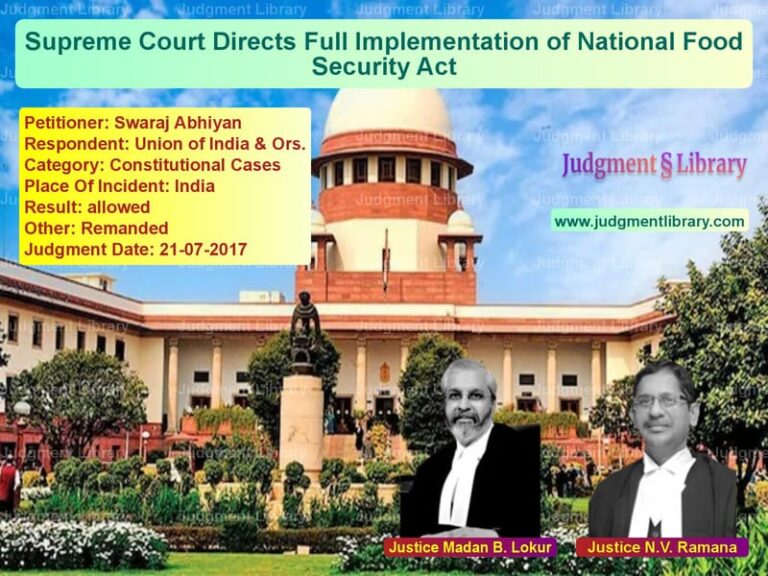Supreme Court Acquits Woman in Murder Case: Benefit of Doubt Given Due to Contradictory Evidence
In a judgment that highlights the critical importance of consistent evidence in criminal convictions, the Supreme Court of India recently acquitted a woman who had been sentenced to life imprisonment for murder, granting her the benefit of doubt due to multiple contradictions in the prosecution’s case. The case, which involved the fatal beating of a man near a temple premises, demonstrates how even serious criminal charges must meet rigorous standards of proof, and how reasonable doubts can emerge from careful examination of medical evidence, witness testimonies, and crime scene details.
The case dates back to March 23, 1999, when Shyam Kali Dubey, the appellant, along with her husband, was accused of beating a man to death with sticks near a temple. The prosecution alleged that the motive stemmed from an altercation earlier that day when the appellant attempted to graze her cattle in the deceased’s field. When the deceased objected, stating that the land had not been harvested yet, the appellant allegedly ignored his concerns, leading to a physical confrontation where the deceased pushed her, and she retaliated by beating him with a stick taken from her son. After being taken away from the scene by her son and mother-in-law, the appellant reportedly threatened to return with her husband, a threat that the prosecution claimed was later executed, resulting in the victim’s death.
The Medical Evidence and Time Discrepancies
The Supreme Court carefully examined the medical evidence presented by PW-6, the doctor who conducted the autopsy. The doctor had documented 13 injuries on the deceased’s body and opined that “the death was due to acute circulatory failure and asphyxia, due to regurgitation of blood in bronchus and trachea. Death was also opined to be due to the head injury caused by a hard and blunt object.”
However, a critical discrepancy emerged during cross-examination, where “PW-6 stated that the autopsy was conducted at 4 in the evening of 24.03.1999 and the death could have been caused between 10 to 12 in the night i.e. the night of 23.03.1999.” The court specifically noted this contradiction, observing that “this since the incident, as the prosecution alleges in front of a number of eyewitnesses, was stated to be at 7 O’clock in the night.”
This time discrepancy became a central point in the court’s analysis, as it created uncertainty about when exactly the death occurred and whether it could be directly linked to the incident described by the eyewitnesses.
Witness Testimonies and Dying Declaration
The prosecution relied heavily on several eyewitnesses, including PW-1, PW-2, and PW-4 (neighbors of the deceased) and PW-7 (the father of the deceased). These witnesses claimed to have heard the victim name his attackers, which would constitute a dying declaration with significant legal weight. However, the court noted that “the statement of the deceased about the perpetrators, has the force of a dying declaration. However, this was not reckoned either by the trial court or by the High Court; presumably due to the improbability of such a statement having been made.”
The court observed inconsistencies in the witness accounts: “The father of the deceased PW-7, whose house is nearby, deposed that he not only witnessed the attack by the accused, but he also heard the victim shouting that he was being beaten to death by the accused. The other eye-witnesses who also came to the scene of crime, hearing shouts, do not speak of any persons having been named.”
This discrepancy in witness accounts regarding whether the victim actually named his attackers raised serious questions about the reliability of the dying declaration.
Crime Scene Anomalies and Unexplained Injuries
One of the most puzzling aspects of the case was the location where the body was found. The court noted that “the body of the deceased was found by the police in the courtyard of his own house, while the incident is said to have occurred near the temple.” This raised questions about why the injured victim was moved from the crime scene to his house rather than to a hospital.
The court questioned this anomaly: “When the incident occurred at 7 O’clock, there is no explanation as to why the injured victim was taken to the house and not to the hospital.” This became particularly significant when considered alongside the medical evidence about the time of death.
Perhaps the most disturbing element noted by the court was “the injury found on the body of the father and mother of the deceased.” The same doctor who conducted the autopsy on the victim “also examined the father and mother of the deceased on the same day. Incised wounds were found on both their bodies which were opined to have been caused by a sharp-edged weapon like an axe or a knife.” Even more remarkably, “The Doctor also opined that the aforementioned injuries sustained by PW-7 and his wife could have been self-inflicted.”
Read also: https://judgmentlibrary.com/supreme-court-reinstates-murder-conviction-in-bihar-fire-tragedy-case/
Family Discord and Motive Questions
The defense presented evidence of family discord that provided an alternative perspective on the case. During cross-examination, “PW-7 admitted that his son, the deceased had been abusing and threatening him, and his other children were sent to Rampur due to such threats.” Although PW-7 asserted that he had no enmity with his son, “he admitted that there was a quarrel with regard to partition.”
The court found this family conflict highly relevant, stating that “This has to be looked at, in juxtaposition with the unexplained injuries on the body of the father and mother of the deceased; which the prosecution ought to have explained.”
Recovery of Evidence and Investigation Lapses
The court also noted shortcomings in the investigation and evidence collection. While the investigating officer PW-10 spoke of recovering weapons from both the appellant and her husband, “PW-9 the witness to recovery declined to prove the prosecution story of a recovery from the husband of the appellant but affirmed the recovery of a danda from the appellant.”
More importantly, “Though, the danda recovered on the confession statement of the appellant was spoken of as blood stained, it was not sent for any chemical examination. The danda was also not confronted to PW-6, the Doctor to get his opinion whether the injury which led to the death could have been caused by the said weapon.” These investigative lapses further weakened the prosecution’s case.
The Supreme Court’s Reasoning
After meticulously examining all the evidence, the Supreme Court identified multiple areas of concern that collectively created reasonable doubt. The court acknowledged that while related witnesses are not automatically unreliable, in this specific case, “a defence is setup of an enmity between the victim and his family which has been spoken of by the father of the victim.”
The court summarized the cumulative effect of the inconsistencies: “Admittedly, there were unexplained injuries on the parents of the victim which were also caused by a cutting weapon. Coupled with this is the fact that the body of the deceased, was found in the courtyard of his own house; when the scene of occurrence, as per the prosecution, was elsewhere. There is also no clarity as to the time when the death was occasioned, so as to garner support from the medical evidence.”
The court made a crucial observation about the eyewitness testimony: “The eye-witness testimony of a frontal assault is only of PW-7, who did not have a very good relationship with the deceased, his son. The other eyewitnesses converged on the scene of occurrence, hearing cries and spoke of having seen the accused fleeing from the site with sticks in their hands. None other than PW-7, witnessed the alleged attack on the deceased victim.”
Regarding the dying declaration, the court found it “improbable” and noted that it had not been properly considered by the lower courts.
The Final Judgment and Acquittal
Based on its comprehensive analysis, the Supreme Court concluded that “In the prospect of the above findings, we are of the opinion that the appellant should be given the benefit of doubt.” The court accordingly “set aside” the order of conviction entered by the trial court and confirmed by the High Court.
The court ordered that “The appellant, hence, stands acquitted and she shall be released forthwith, if she is not wanted in any other case, and if she is on bail, the bail bonds shall stand cancelled.”
Broader Legal Implications
This judgment serves as an important reminder of several fundamental principles in criminal jurisprudence. First, it reinforces that the burden of proof in criminal cases always rests with the prosecution, and any reasonable doubt must benefit the accused. Second, it demonstrates how multiple minor inconsistencies, when considered together, can create sufficient doubt to warrant acquittal, even in serious cases like murder.
The case also highlights the importance of thorough investigation, particularly the need to explain unusual circumstances like the unexplained injuries on the victim’s parents and the movement of the body from the crime scene. The failure to conduct chemical analysis on the recovered weapon and to establish a clear timeline between the alleged incident and the time of death further weakened the prosecution’s case.
Ultimately, the Supreme Court’s decision underscores that while crimes must be punished, convictions must be based on solid, consistent evidence that leaves no room for reasonable doubt. The benefit of doubt principle, though sometimes controversial in emotionally charged cases, remains a cornerstone of criminal justice designed to prevent wrongful convictions.
This judgment will likely be cited in future cases where similar patterns of contradictory evidence, unexplained circumstances, and investigative lapses create reasonable doubt about the prosecution’s version of events.
Petitioner Name: Shyam Kali Dubey.Respondent Name: State of Madhya Pradesh.Judgment By: Justice K. Vinod Chandran, Justice N. V. Anjaria.Place Of Incident: Temple premises.Judgment Date: 08-08-2025.Result: allowed.
Don’t miss out on the full details! Download the complete judgment in PDF format below and gain valuable insights instantly!
Download Judgment: shyam-kali-dubey-vs-state-of-madhya-prad-supreme-court-of-india-judgment-dated-08-08-2025.pdf
Directly Download Judgment: Directly download this Judgment
See all petitions in Murder Cases
See all petitions in Bail and Anticipatory Bail
See all petitions in Attempt to Murder Cases
See all petitions in Custodial Deaths and Police Misconduct
See all petitions in Other Cases
See all petitions in Judgment by K. Vinod Chandran
See all petitions in Judgment by N.V. Anjaria
See all petitions in allowed
See all petitions in supreme court of India judgments August 2025
See all petitions in 2025 judgments
See all posts in Criminal Cases Category
See all allowed petitions in Criminal Cases Category
See all Dismissed petitions in Criminal Cases Category
See all partially allowed petitions in Criminal Cases Category







